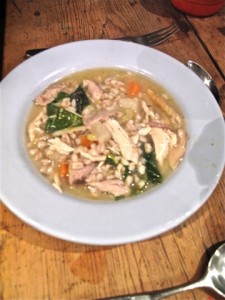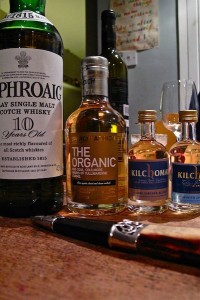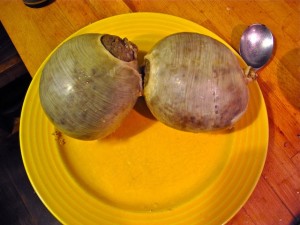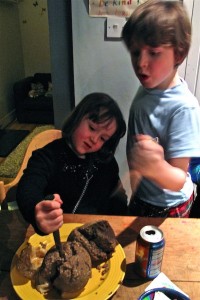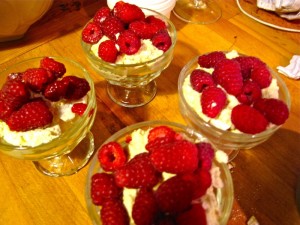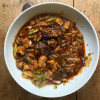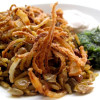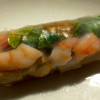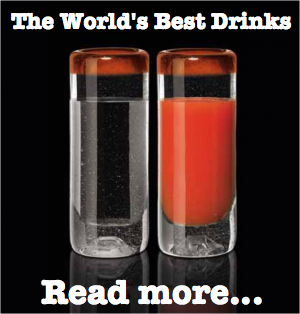Second country up – Scotland – and it seemed churlish not to divert from our random choosing system and force the Scotland card to coincide with Burn’s Night on January 25th.
Yes, yes, it’s a few weeks past but I’m still catching up – this is no easy undertaking with a full-time job what with sourcing ingredients, choosing recipes and then cooking everything. At time of writing I have cooked Peru and Greece, and eaten Japan, with Mexico coming up this weekend. So stay tuned…
Burns
Coming as it does at the tail end of a week that started with “Blue Monday”, the most depressing day of the year (actually a load of auld guff as PROVEN here) Burns Night has become a new seasonal highlight for those looking to break the long dark days of winter – even non-Jocks are getting in on the act, with haggis widely available, even as far down south as here in Totnes.
Burns’ Night always seems like such a good idea (at the time): it’s a month since New Year’s and several long weeks until Easter with nothing but pancake day (an inferior celebration in my opinion, heralding as it does 40 days of austerity and murderous on the gluten intolerant) to break the grim, dark monotony. Of course, there’s always Chinese New Year…
Robert Burns is 254 years old this year. Dead now, obviously, but living on in a night of whisky, haggis, tartan and, of course, incomprehensible (to Sassenachs) verse. To be fair even my Dad, who is officially Scottish and speaker of that most difficult of dialects Aberdonian, struggled (a little) with the Address To The Haggis, although that may have been to do with the whisky.
Burns was born in Ayrshire in 1759 and worked on the family farm, but spent much of his time enjoying poetry, drink and women and by 27 he was nationally famous as the Ploughman Poet. He’s probably most famous for writing Auld Land Syne and Scots Wha Hae.
The Menu
There are some obligatory choices when it comes to Burns Night – the main course has to be Haggis, with Neeps and Tatties. Starter is usually Cock A Leekie or Scotch Broth, and pudding Cloutie Dumpling or Cranachan, although given that raspberries are only in season from July until September, that’s more of a recent choice. Still, facing steamed dumpling after a bag of offal and mash is more than I could handle.
Burns suppers tend to follow a set format, laid down in the first Burns Clubs in the 18th century. First the host welcomes the guests who all mingle in their kilts and tam o’shanters; some Scottish people are even known to drink the odd whisky at this stage of the evening.
Then follows grace is said, Traditionally this is the Selkirk Grace, so called because Burns apparently read it a dinner given by the Earl Of Selkirk.
Some hae eat and canna eat
And some whid eat that wint it
Be we hae meat, and we can eat
So let the Lord be thankit
Said beautifully by my Mum. Then soup is served.
Scotch Broth
Traditionally made with chicken or lamb, this is a hearty, warming soup – perfect preparation for the airy lightness of haggis.
I used a whole chicken (around 1,5kg), removed the skin and breasts, covered with water and added:
- 2 large carrots, peeled and diced
- 1 large white turnip – should be swede really – peeled and diced
- 2 onions, chopped
- 1 large spring of thyme
- 1 bay leaf
Bring to boil, skim off any fat or grungy bits, until the chicken is cooked. You can tell when it’s starting to come away from the bone. I took the breasts off the chicken to start with as it seemed a waste to overcook them.
At this stage I took the chicken out of the broth and took the meat off the bone with a fork. I put it all back into the broth and added:
250g pearl barley.
Actually, I cheated. I’d already used the pearl barley to make barley water so I used some spelt from an already open packet but it has the same affect with a slightly larger grain. Good stuff though. It takes around 20 minutes or so to cook and you want it slightly al dente.
Around 10 minutes in to cooking I added the chopped chicken breasts and seasoned with salt and black pepper.
It’s a really easy dish but fantastically tasty and one of the best ways to really bring out a chicken’s flavour.
Scotland’s Best Drink
My boy Louie loved the soup, considering it “best ever” but my little girl Darcy was less keen. Time to bring out the big guns and wean them on to Scotland’s best drink.
No, not whisky.
Irn Bru
Made in Scotland it may be but Irn Bru is not actually made from girders. One can only presume that my complaint to the ASA has been upheld as I haven’t seen that slogan for a while. I was insisting on a far less catchy but more accurate “Made In Scotland from water, sugar, indeterminate flavourings and bright orange and – according to the Food Standards Agency – possibly unhealthy colourings.”
All that said it is delicious and my kids love it and only went lightly beserk afterwards. Irn Bru has long been said to be one of the only soft drinks to outsell Coca Cola in its native market – one of the others being Inka Kola (more on that to follow) – and vodka and Irn Bru is more popular night club drink than Red Bull and vodka, although with similar devastating affect.
… and Whisky
Scotland’s true national drink is undoubtedly whisky – uisge beatha. Records of distilling in Scotland go back to 1494 but back then it was a little rough round the edges and occasionally fatal. The oldest surviving distillery is said to be Glenturret, founded in 1775 in Perthshire and today there are estimated to be around 120 or so distilleries across the country.
There are well defined guidelines governed by the Scotch Whisky Regulations 2009 that define what can be called Scotch including that it must be aged in oak barrels for three years, must be made from water and malted barley, and produced at a distillery in Scotland.
There are two basic types – single malt and blended whisky. Scottish single malts are widely regarded as the best in the world and are produced only from water and malted barley at a single distillery in pot stills.
For our Burns Night we tried four different single malt whiskies – Laphroaig, a well-known Islay malt that has a deeply peaty taste and my favourite especially when drunk alongside Lapsang Souchong tea, Kilchoman is another Islay malt and one of the smallest and newest distilleries in Scotland. Only built in 2005 – the first built on the island for nearly 125 years – they grow their barley on the distillery farm. We tried a very new Winter 2010 release (finished in bourbon barrels, very light, easy to drink) and a 2006 Vintage release.
We also had “The Organic” Bruichladdich – yet another Islay malt made with organic barley which was awarded ‘exceptional” status by Michelin. Pale gold, sweet and subtly malty. They do an excellent gin too, called The Botanist.
Drinking whisky all through a meal is pretty hardcore imho so we got stuck in to some Cote Du Rhone, which we all agreed was authentic due to the “Auld Alliance”.
Haggis, Neeps & Tatties
The main event of Burns Night is the haggis, frequently piped in on a silver platter, and always accompanied by Burns ‘Address To A Haggis’ – here in full:
Fair fa’ your honest, sonsie face,
Great chieftain o’ the pudding-race!
Aboon them a’ ye tak your place,
Painch, tripe, or thairm :
Weel are ye wordy o’a grace
As lang’s my arm.
The groaning trencher there ye fill,
Your hurdies like a distant hill,
Your pin wad help to mend a mill
In time o’need,
While thro’ your pores the dews distil
Like amber bead.
His knife see rustic Labour dight,
At this point you’re supposed to cut open the haggis. My kids both plunged their sgian-dubhs (the knife you wear in your sock with a kilt) into the haggis and scattered clumps of offal all over themselves and the table.
An’ cut you up wi’ ready sleight,
Trenching your gushing entrails bright,
Like ony ditch;
And then, O what a glorious sight,
Warm-reekin’, rich!
Then, horn for horn, they stretch an’ strive:
Deil tak the hindmost! on they drive,
Till a’ their weel-swall’d kytes belyve
Are bent like drums;
Then auld Guidman, maist like to rive,
Bethankit! hums.
Is there that owre his French ragout
Or olio that wad staw a sow,
Or fricassee wad make her spew
Wi’ perfect sconner,
Looks down wi’ sneering, scornfu’ view
On sic a dinner?
Poor devil! see him owre his trash,
As feckless as wither’d rash,
His spindle shank, a guid whip-lash;
His nieve a nit;
Thro’ bloody flood or field to dash,
O how unfit!
But mark the Rustic, haggis-fed,
The trembling earth resounds his tread.
Clap in his walie nieve a blade,
He’ll mak it whissle;
An’ legs an’ arms, an’ heads will sned,
Like taps o’ thrissle.
Ye Pow’rs, wha mak mankind your care,
And dish them out their bill o’ fare,
Auld Scotland wants nae skinking ware
That jaups in luggies;
But, if ye wish her gratefu’ prayer
Gie her a haggis!
What Is A Haggis?
So what actually is a haggis? Traditionally it contains the sheep’s pluck – heart, liver and lungs – cooked with onion, oatmeal, suet, stock and then encased in the animal’s stomach. It’s a way of using up all easily spoiled parts of the animal in a handy container. These days there dozens of different versions – and I’ve heard that MacSween’s vegetarian haggis is an exceptional alternative to the meat version and a great dish in its own right
We had our haggis specially imported by my Mum and Dad from Andrew Gordon’s butchers in Aberdeen, who had apparently sold 1 tonne of haggis over Burns’ Week.
Because it’s already cooked, the haggis just needs a gentle steaming for 10 – 15 minutes to warm through properly. Part way through we added some white pudding (“mealy pudding”) – basically a haggis without the meat (suet, oatmeal, onions, spice) and another gut-buster.
The Holy Trinity that is the Burns Supper main course also comprises tatties and neeps. Tatties need no explanation (until we get to Peru) but all sorts of confusion abounds with what a neep is – not a turnip but a swede and adding a much needed splash of colour to the plate. I was tempted to use the school dinners ice cream scoop for the mash and neeps but time was against us. So, it turned was the veg stall at the market who didn’t actually have swede so we had to use real turnips instead. Oh, the humanity!
Read more about haggis and neeps
The great thing about this dish is that it barely needs a recipe. That said, it can be a little dry so I whipped up a quick gravy with some of the broth, a little red wine and redcurrant jelly which I reduced until syrupy. Sometimes people have a whisky cream sauce but to me that seems like a bridge too far – especially given what we were having for pudding.
Pudding – Cranachan
While raspberries in February may have been a problem in Burns’ day, they are widely available here.
While the environmental impact of importing soft fruit out of season may be onerous, I was pressed for time and the thought of making (and eating) cloutie dumpling filled me with terror.
The prospect of a long-term constipation averted, I settled on a version of Cranachan, traditionally made with cream, raspberries, oatmeal, whisky and honey.
I already had a massive batch of meringues from some leftover egg whites so I was going to go all Heston and do a complicated version with syrups, jellies and powders but in the end I had to throw it all together at the last minute.
Cranachan
- 1 pint of double cream, whipped
- A couple of large handfuls of oats – I used jumbo oats
- A shot of single malt whisky – not too peaty
- 3 tsb honey
- 2 punnets of raspberries
- 2 large meringues, broken into bite-sized pieces
– Toast the oats in the oven until golden brown
– Allow to cool and add to the whipped cream with the whisky and honey
– Put the meringue pieces in the base of your serving dish, cover with the cream and then put loads of raspberries on top
“Done” as Gordon Ramsay would say.
The Aftermath
As I sat watching Rylan Clark win the final of Celebrity Big Brother, sprawled over the sofa with my belt buckle undone to relieve the pressure on my stomach, I mused how this was the perfect food for those long winter nights in the bothies – it makes you feel full, boiling hot and unable to move for several hours. Not sure what they did back then for Rennies either – presumably some kind of thistle tincture?

